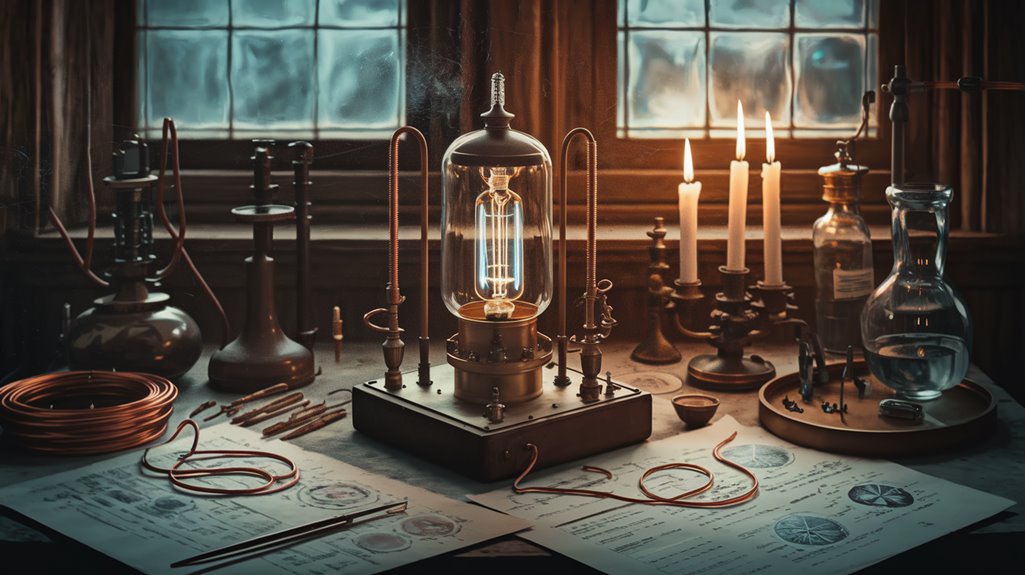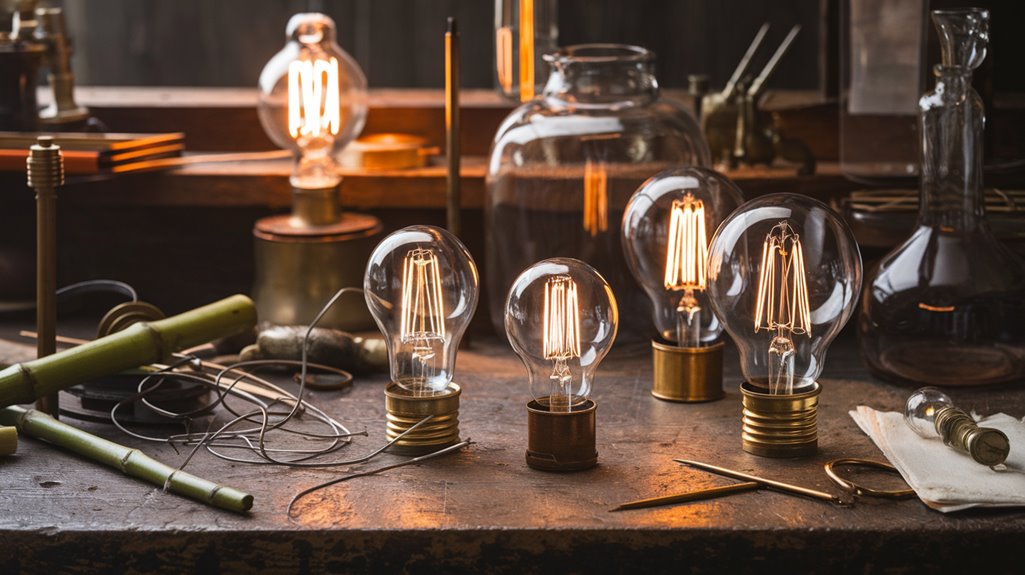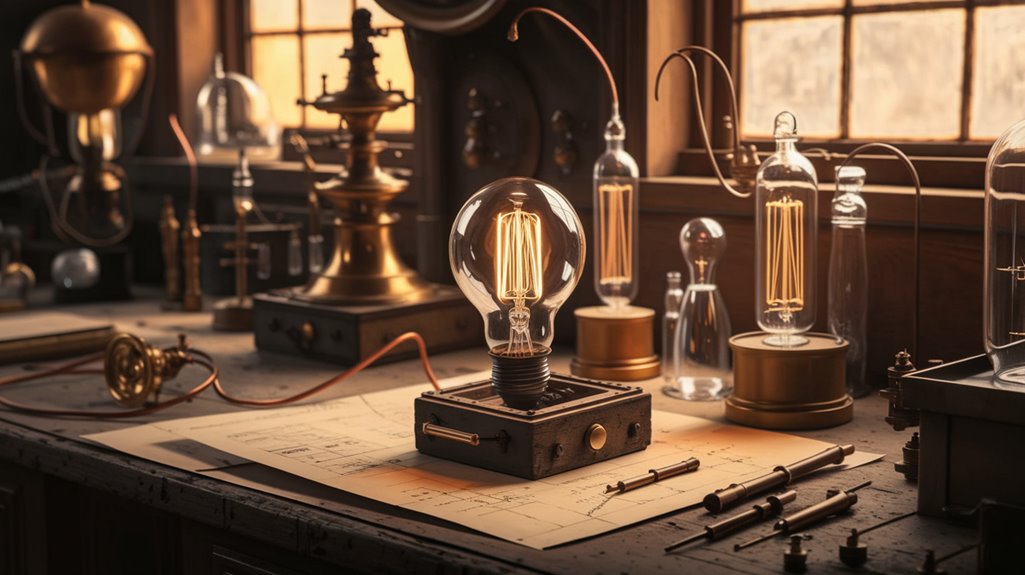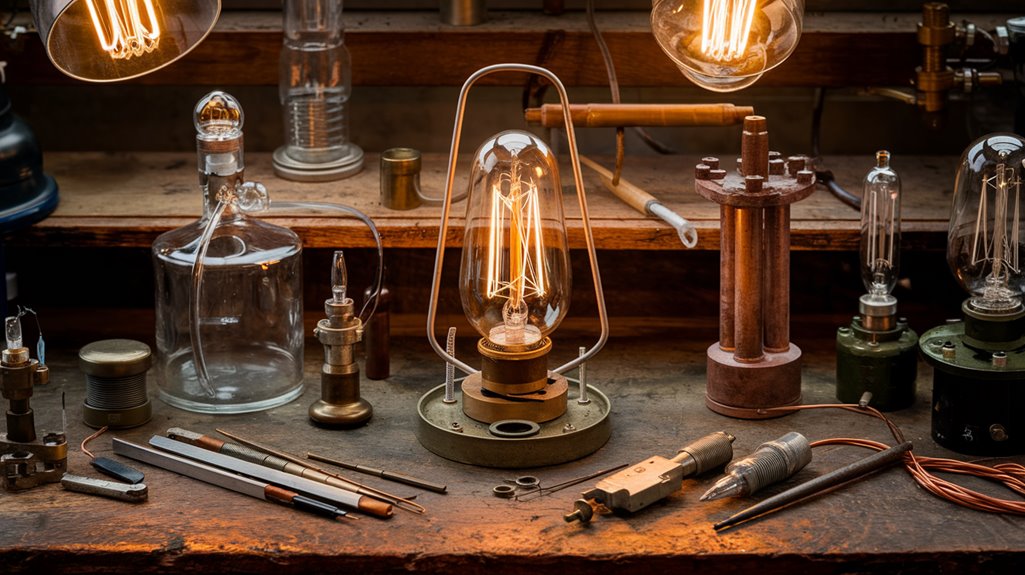Who Really Invented the Light Bulb? Overlooked Engineers
You might be surprised to learn that electric light existed nearly 70 years before Edison's famous breakthrough, when Humphry Davy created an arc lamp using charcoal electrodes in 1809. While Edison's name has become synonymous with the light bulb's invention, a complex web of engineers, inventors, and scientists laid the groundwork for his success. Their overlooked contributions, from carbon filament designs to vacuum technology, reveal a fascinating story of collaborative innovation that's far richer than the single-inventor narrative you've likely heard.
The Pre-Edison Pioneers: Early Experimenters With Electric Light

While Thomas Edison is often credited with inventing the light bulb, the journey toward electric light began decades before his breakthrough. You might be surprised to learn that British scientist Humphry Davy created the first electric light in 1802 using a carbon arc, demonstrating it publicly at London's Royal Institute in 1809.
This groundbreaking achievement proved that electricity could produce light through heat.
In the following decades, several inventors made significant strides. James Bowman Lindsay showcased an electric light in Scotland by 1835, while Warren de la Rue introduced a vital innovation in 1840 by enclosing a platinum filament in a vacuum tube. These early experiments required massive battery power to function.
Frederick de Moleyns followed with the first patented incandescent bulb in 1841, and Joseph Swan began his pioneering work with carbonized paper filaments in 1850. Henry Woodward and Mathew Evans made notable progress when they developed their carbon rod lamps in 1874.
Beyond Edison and Swan: Lesser-Known Contributors
Although Edison and Swan dominate the light bulb's history, numerous lesser-known inventors made significant contributions to its development.
Before their breakthroughs, Humphry Davy created the first electric light in 1806 by connecting carbon rods to a battery, while Benjamin Franklin's electricity experiments laid essential groundwork for future innovations.
You'll find that the light bulb's evolution wasn't a solo journey but rather a collaborative effort spanning continents. Warren de la Rue made early progress with his platinum filament design.
These overlooked pioneers include Canadian inventors Woodward and Evans, who patented the use of nitrogen in bulbs, and Louis Howard Latimer, who worked alongside Edison creating patent sketches.
The invention's story is more complex than commonly believed, influenced by factors like national pride, media coverage, and commercial viability. Innovation history shows that many inventions are built upon previous ideas and technologies.
Each contributor played an important role in shaping the modern light bulb we use today.
The Critical Role of Supporting Technologies
The invention of the light bulb extends far beyond individual genius to encompass a network of supporting technologies that made it possible.
You'll find that essential electrical advancements like Volta's battery and improved wire insulation laid the groundwork for success. Without these supporting technologies, even the most brilliant filament design would have failed. Modern smart bulb systems continue this legacy of supporting technologies by integrating with home automation platforms. Carbon filaments developed by Lewis Latimer made bulbs more durable and affordable for widespread use.
The development of vacuum technology and advanced glass manufacturing enabled bulbs to last longer and perform better.
You can trace how standardization of bulb sizes and the evolution of power distribution systems made widespread adoption feasible.
Additionally, the creation of effective switches and controls made the technology practical for everyday use.
These interconnected innovations worked together, transforming the light bulb from an inventor's dream into a revolutionary technology that changed how we live.
From Laboratory to Commercial Success: Key Breakthroughs
Inside Edison's groundbreaking Menlo Park laboratory, systematic experimentation and relentless innovation propelled the light bulb from concept to commercial reality.
You'll find that Edison's team methodically tested various filament materials, from platinum to carbon, before achieving their breakthrough with high-resistance carbon filament electric lamps in 1880. Their bamboo filament creation could sustain 1,200 hours of illumination.
This revolutionary work took place in the first industrial lab, where Edison established a new model for organized research and development in 1876.
The Legacy of Collaborative Innovation in Lighting History

Through decades of collaborative innovation, inventors and engineers worldwide shaped the evolution of electric lighting far beyond any single person's contribution.
What you'll find remarkable is how collaborative synergy between figures like Swan, Edison, and Latimer drove rapid advancement – from Volta's early battery to commercially viable bulbs.
The story reveals the power of innovation networks spanning continents and generations.
You can trace how De La Rue's platinum filaments influenced Swan's carbonized paper designs, while Latimer's manufacturing breakthroughs made mass production possible.
Today's digital age has only accelerated this model of shared progress, as solving complex challenges requires diverse expertise and perspectives.
When you examine lighting's history, you'll see it wasn't just about individual genius but the combined efforts of many brilliant minds working across time and space.
The transition away from the solo inventor myth toward multidisciplinary think tanks reflects our modern understanding that breakthrough innovations require diverse skill sets and knowledge bases.










